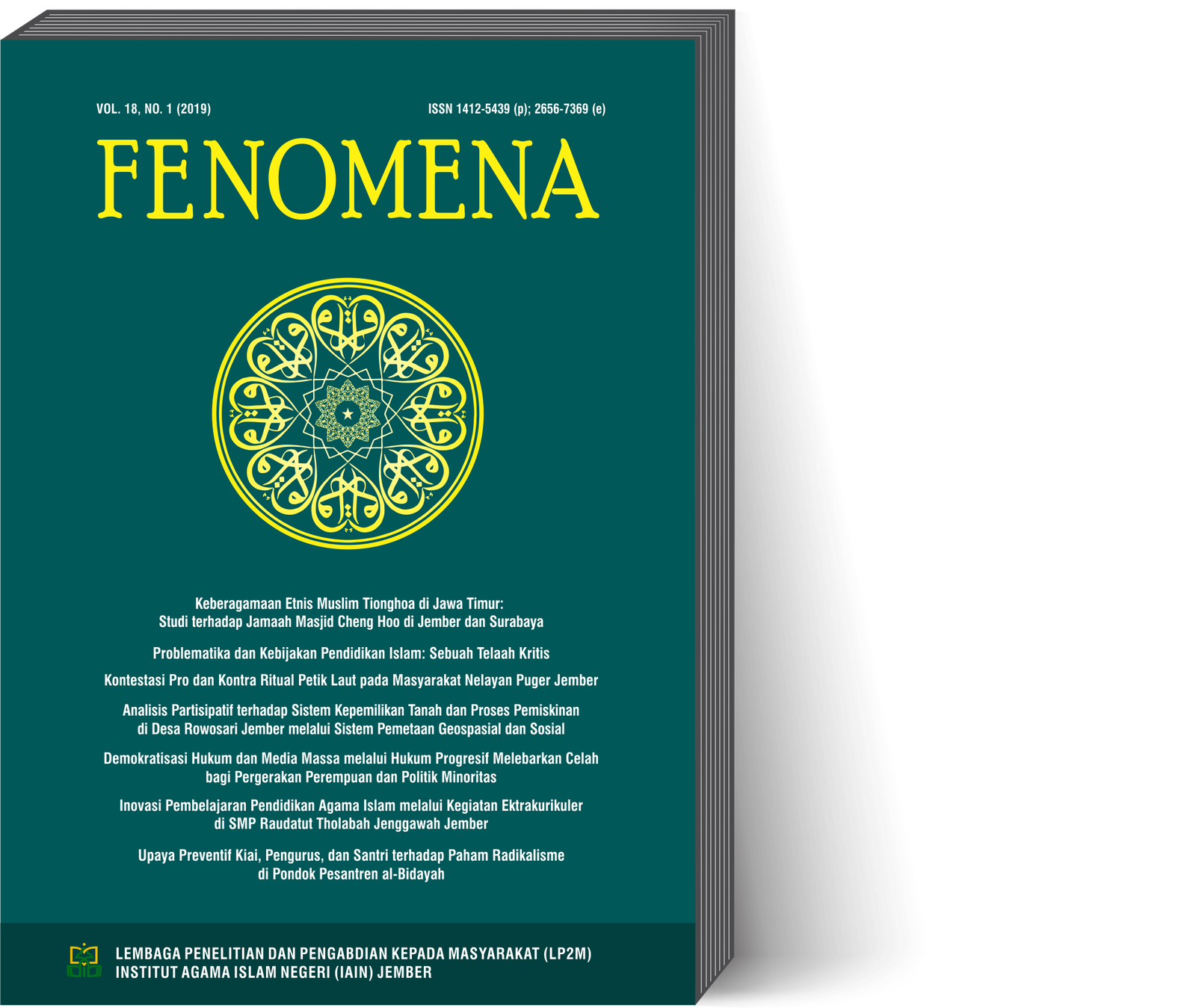ANALISIS PARTISIPATIF TERHADAP SISTEM KEPEMILIKAN TANAH DAN PROSES PEMISKINAN DI DESA ROWOSARI JEMBER MELALUI SISTEM PEMETAAN GEOSPASIAL DAN SOSIAL
Participatory Analysis Of Land Ownership System And Impoverishment Process In Rowosari Village Jember Through Geospatial And Social Mapping System
DOI:
https://doi.org/10.35719/fenomena.v18i1.11Rowosari has a beautiful landscape and natural layout. A row of circular pine hills forms a horseshoe in the north, east, and south. On the east side, back to the pine hill, is Raung Mountain, which is almost always covered with clouds and rises to an altitude of 3,344 masl, which makes it the second highest mountain in East Java after Semeru Mount. The volcano in the Ijen mountain complex area stuck its feet in three districts Besuki, Jember, Bondowoso, and Banyuwangi. However, at one settlement point, namely the Karang Tengah village, which is part of the Barat Sawah village, residential settlements are concentrated in an area of 1,728 hectares. These settlements go north from the village road, surrounded by stretches of fields and small rivers. There are two entrances to this settlement, west, and east. There are 56 heads of families living here with 51 houses. Houses are lined up and stretched, following the taneyan lanjhang-pattern consisting of several houses inhabited by several families, between settlements and fields restricted with rivers and plants. The contrasting picture between the abundance of natural resources and the social conditions of the Rowosari community raises the general question of this study: why do the agricultural area and the wealth of natural resources not correlate with the population welfare? What happens in the relationship between humans and their homeland? Because the analysis of production relations in the agricultural sector is the backbone of the socio-economic structure of rural society, the research is the central theme of this study. What happened in the village, especially in the West field of Rowosari Village, can be solved, for example, by institutionalizing savings and loans cooperatives, processing agriculture by using organic farming systems, and developing village tourism by utilizing village potential. Nature tourism: panoramic views of mountains, waterfalls, panoramic views of fields and rivers flowing with clear water, become the main attraction to be developed as a village tour. Livestock and fisheries can also be created because abundant river and green food sources exist. Village funds can be used for that. The priority of village development should be based on analyzing data from participatory mapping, not by a handful of village government elites. The importance of the programs should be directed by building food security and creating jobs towards village economic sovereignty. The community could manage the land in the forested area. However, the land management rights are given to the Chinese ethnic who worked it for cash crops such as sengon and coffee. Village people only become wage laborers to care for, fertilize and harvest the results. Because of the rugged terrain to reach the location, the villagers were finally reluctant to manage the land with little wage and erratic work. They are forced to look for work outside the village. There must be good faith and political decisions by the village government, for example, by making regulations regarding the prohibition of selling agricultural land to people outside the village so that the land does not turn into housing or become an asset for investment which certainly does not commit to agricultural development. In addition, villages must develop BUMDES as an economic effort by opening jobs to improve the community welfare, especially for those who do not have jobs and agricultural land. Management of zakat, infaq, and shodaqoh from rich people, if appropriately managed, can become business capital or help alleviate those who need it; this could prevent villagers from migrating to the city. Because if many villagers relocate to the city when they return, they will bring the town's culture that is not in line with the values and norms of the village.
Downloads
References
Clifford Geertz, Involusi Pertanian: Proses Perubahan ekologi Di Indonesia, terjemahan S. Supomo, (Jakarta: Bhratara Karya Aksara, 1976)
Hiroyoshi Kano, Pagelaran: Anatomi Sosial Ekonomi Pelapisan Masyarakat Tani Di Sebuah Desa Jawa Timur, (Yogyakarta: Gadjah Mada University Press, 1990)
http://desarowosarisumberjambe.blogspot.co.id/p/blog-page.html
J.H. Boeke, Prakapitalisme di Asia, terj. D. Projosiswoyo, (Jakarta: Sinar Harapan, 1983)
Margo L. Lyon, Bases of Cinflict in Rural Java, Research Monograph Series No. 3, (Center for South and Southeast Asia Studies, University of California, 1970)
Sajogyo (peny.), Bunga Rampai Perekonomian Desa, Bogor: Yayasan Obor, 1982.
Sajogyo, “Pertanian, landasan tolak bagi pengembangan bangsa Indonesia”, kata pengantar dalam buku terjemahan karya C. Geeertz, Involusi Pertanian, Proses Perubahan Ekologi di Indonesia, Jakarta, 1976.
Statistik Daerah Kecamatan Sumberjambe Tahun 2015, No. Publikasi: 35095.1560, Katalog BPS: 1101002.3509260. Publikasi PDF dengan alamat http://jemberkab.bps.go.id.
Tania Murray Li, The Will to Improve, Perencanaan, kekuasaan dan Pembangunan di Indonesia, terj. Hery Santoso dan Pujo Semedi, Tangerang Selatan: Marjin Kiri, 2012.
William L. Colier, Agricultural Evolution in Java: The Decline of Shared Poverty and Involution, (Bogor, n.d. c, 1977)
Downloads
Published
Issue
Section
License
Copyright (c) 2019 Muhammad Ardiansyah, Moh Salman Hamdani

This work is licensed under a Creative Commons Attribution-NonCommercial 4.0 International License.










 FENOMENA licensed under Creative Commons Attribution-NonCommercial 4.0 International License
FENOMENA licensed under Creative Commons Attribution-NonCommercial 4.0 International License